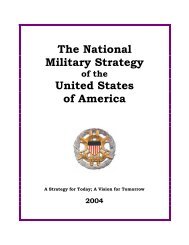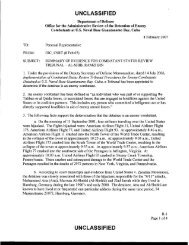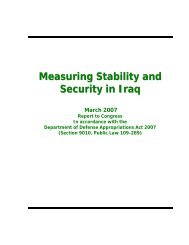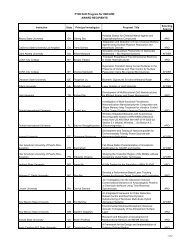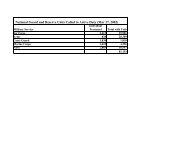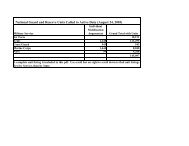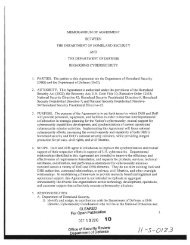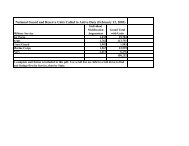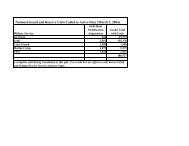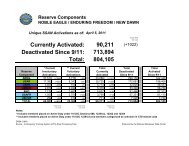Report - United States Department of Defense
Report - United States Department of Defense
Report - United States Department of Defense
You also want an ePaper? Increase the reach of your titles
YUMPU automatically turns print PDFs into web optimized ePapers that Google loves.
UNCLASSIFIED<br />
The still-nascent ANP logistics system is challenged by insurgent threats in such basic functions<br />
as the delivery <strong>of</strong> fuel and water. Contracted support, especially in the South, is unavailable due<br />
to a lack <strong>of</strong> providers in reasonable distance to fielded units. ABP is also heavily reliant on<br />
Afghan air support to sustain, evacuate casualties, or relieve police forces that spend long tours<br />
<strong>of</strong> duty in isolated border stations. The ABP do not, however, get priority for support from<br />
Afghan air assets, which are extremely limited.<br />
In order to address some <strong>of</strong> these challenges, NTM-A approved new capabilities for resourcing<br />
that will increase the effectiveness <strong>of</strong> the ABP. Three route clearance companies (RCC) will be<br />
stood up in the zones with the highest rate <strong>of</strong> IED attacks to improve the protection <strong>of</strong> ABP while<br />
they patrol or sustain their forces via GLOCs. Border Control Point (BCP) equipment will be<br />
provided to improve the detection <strong>of</strong> precursor’s chemicals and opiates. More heavy-weapons<br />
capabilities will be introduced to all zones to help defend against a persistent enemy that is<br />
currently much better armed than the ABP.<br />
Recent improvements in pr<strong>of</strong>essionalization efforts have been realized with a top-down focus by<br />
ABP leadership in ongoing training, education and literacy. NTM-A and ABP have collaborated<br />
to significantly increase training in many functional areas, including intelligence, vehicle and<br />
weapons maintenance, communications and medical and personnel support. An NCO-level<br />
course for police employed at airports and BCPs was developed with Afghan support and is<br />
being delivered in partnership with bilateral contributors. The methodology by which this<br />
training was developed is the model that the ABP will use to create follow-on border police<br />
specific courses. NTM-A also has concentrated on building a train-the-trainer capacity within<br />
the ABP commander’s organization, per his request.<br />
The C2 abilities <strong>of</strong> ABP have improved with better coordination with the MoI, laterally within<br />
the HQ, down to subordinate units, and with neighboring countries’ border patrols. ABP and<br />
ANSF leadership continue to engage in multiple discussions with neighboring country<br />
counterparts to improve border relations. Efforts to build pan-ANSF supporting relationships<br />
and improve cooperation along neighboring borders, especially Pakistan, are still enabled and<br />
dependent on coalition forces. Moving forward, the main effort <strong>of</strong> the coalition forces should be<br />
to continue to foster better communication, coordination and cooperation with other ANSF to<br />
provide layered and in extremis support. This approach is likely the only defensive posture that<br />
will be sufficient to reduce insurgent operations in the border zone.<br />
Positive momentum can be seen with the ABP's mission at the regulated points <strong>of</strong> embarkation,<br />
including 5 airports and 14 BCPs. ABP has also embraced the Combined Comprehensive<br />
Border Strategy (CCBS), under which ISAF supports GIRoA with focused and coherent<br />
nationally endorsed aims to limit the ingress <strong>of</strong> homemade explosives (HMEs) precursor<br />
chemicals, insurgents and weapons, by concentrating effort at selected BCPs. NTM-A is<br />
currently equipping and training police and improving infrastructure at these sites in order to<br />
support the initiative. ISAF personnel assess that if sufficient security and force protection can<br />
be provided; airports and BCPs are the best locations to focus ABP pr<strong>of</strong>essionalization and<br />
corruption reduction efforts beyond 2014.<br />
85



